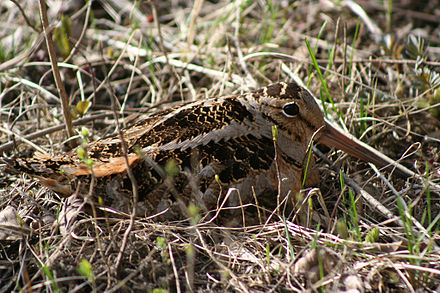Erin Harrington: The 'Timberdoodle' is in trouble
A notably well-camouflaged American woodcock.
From ecoRI News (ecori.org)
Bog sucker. Labrador twister. Night partridge. Timberdoodle. No, these aren’t the names of ’90s alternative punk rock bands. This list is in fact an assortment of nicknames affectionately given to one odd bird, the American woodcock. Or, if you’re a scientist, Scolopax minor.
In the words of a graduate student at the University of Rhode Island, Stephen Brenner, “There’s not too many birds in North America like the woodcock.”
The Timberdoodle is unique for many reasons. This rotund shorebird has a long sandpiper-like beak, short, stubby legs, and arguably the silliest sounding mating call known to mankind. Its eyes are oddly placed near the top of its head, which allows it to simultaneously keep a lookout for predators while also probing for food in the forest soil. It uses its long beak to feel around in the dirt for earthworms, often rocking its body back and forth in a dance that would rival that of an Egyptian, of The Bangles’ persuasion.
While this all sounds fun and silly, unfortunately, the woodcock is in trouble. In fact, for the past four decades, the woodcock population has been decreasing range-wide at roughly 1.2 percent annually, in part because of a lack of open space that the woodcock requires for its mating dances in the sky.
Graduate students and researchers in Scott McWilliams’s lab at URI are trying to figure more out about why the population is in decline and what can be done about it.
What scientists have found out about woodcock so far is that they require early-successional forest. The term seems like a mouthful, but McWilliams said the concept is fairly simple.
“Early-successional forest is an area that has only very young trees and lots of shrubs but would be mature forest if left alone,” he said.
Previous research teams have already found that one main reason why the woodcock population seems to be declining is a continuing loss of their habitat. But the fact of the matter is we still have only a vague idea of what woodcock habitat needs actually are, especially in southern New England.
Tracking habitat preferences
Former URI Ph.D. student Roger Masse was able to use tracking devices on woodcock to determine their movement patterns, and from that data, develop what is known as a “resource selection function.” This model uses sophisticated statistical analysis to analyze woodcock movement data and tell us what components of forest habitat are most important for woodcock given what is available in the area.
Brenner’s research builds off what Masse learned and takes it to the next level. The main question trying to be answered is: Does habitat quality influence the species’ willingness to stay and the movements thereafter once the bird decides to stay?
To answer this question, researchers are swapping woodcock from two different landscapes of two different management qualities and using radio transmitters to track their movements.
“If they’re in good quality habitat, they should be more likely to stay,” McWilliams said. “Whereas, if they’re in poor quality habitat, birds should be more likely to move and go back to where they came from. In short, we're asking the woodcock to tell us which type of landscape they prefer to inhabit.”
By conducting these experiments in forests that are already specifically managed for woodcock habitat needs, scientists and forest managers can come up with more specific plans for increasing numbers of other early-successional species, such as cottontail rabbits, shrubland birds like eastern towhees and prairie warblers, and even flying squirrels. But scientists and forest managers can’t do this work alone.
Recruiting landowners to help
For the past seven years, Bill Buffum’s work at URI has included supporting the RI Coverts Project, a collaborative effort between government and non-governmental organizations to address the need for more early-successional forest in Rhode Island by getting private landowners involved in forest management.
According to Buffum, a research associate in URI’s Department of Natural Resources Science, the biggest challenge for communicating with landowners is that they aren’t easily convinced that clear-cutting is beneficial for wildlife.
“A clear-cut is ugly for a couple of years … it looks like a bomb went off,” Buffum said. “But after about three or four years, the vegetation starts to grow and people start saying, ‘Wow, I’m already seeing the impact. I’m seeing birds I never saw before on my property.’”
Ultimately, the work of the McWilliams lab is important not just because it may help increase the woodcock population, but also because it may help many other species that require early-successional forest habitat. This is why the timberdoodle is referred to as an “umbrella species,” or a species that, once properly managed for, can be beneficial to many other types of species that use the same habitat.
“Whatever kind of critters we’re talking about, species depend on a variety of different habitats,” McWilliams said. “We’ve interfered with the natural sources of disturbance such as beavers and forest fires, and so part of what we have to do is help to recreate that kind of early-successional habitat and provide for those species that especially depend on it.”
Erin Harrington, a Ph.D. student in the Biological and Environmental Sciences program at the University of Rhode Island, runs Project Timberdoodle.
